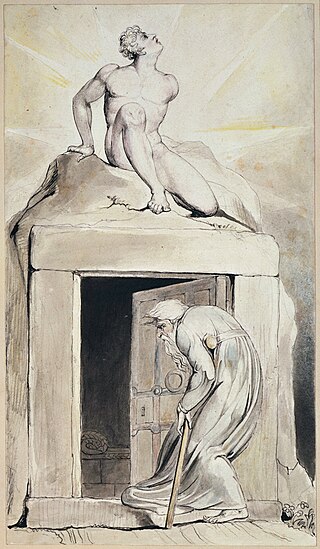
Thomas Hartley Cromek (1809-1873) was an English painter.

Thomas Hartley Cromek (1809-1873) was an English painter.
Cromek was born on 8 August 1809, the son of the engraver Robert Hartley Cromek. [1] He was educated at Enoch Harrison's school in Wakefield; he then attended the Moravian School at Fulneck, and to the Grammar School at Wakefield, before he eventually returning to Harrison. [1]
He had his first lessons in art from James Hunter, a portrait painter at Wakefield, but in 1826 he went to Leeds where he studied landscape painting under Joseph Rhodes, an artist of considerable ability, and also taught himself anatomical drawing. [2]
In 1830 he decided to go to Italy to study the great masters. He passed through Belgium, the Rhineland, Switzerland, and Florence, and at length reached Rome, where he soon attracted attention by the excellence of his drawings and his careful colouring. From 1831 until 1849, with the exception of two short visits to England, Cromek passed his time in visiting and making drawings of the principal buildings and the picturesque scenery of Italy and Greece. [3]
In 1850 he was unanimously elected an Associate of the New Society of Painters in Water-Colours, when he retired to Wakefield, where he died, after a long and painful illness, in 1873. His drawings, which are chiefly to be found in the royal and private collections, are much esteemed for the beauty of their colouring and their truthfulness to nature. [4]

Thomas Stothard was a British painter, illustrator and engraver. His son, Robert T. Stothard was a painter : he painted the proclamation outside York Minster of Queen Victoria's accession to the throne in June 1837.
Events in the year 1812 in Art.
The Havell family of Reading, Berkshire, England, included a number of notable engravers, etchers and painters, as well as writers, publishers, educators, and musicians. In particular, members of this family were among the foremost practitioners of aquatint; and had a long association with Indian art and culture. The family first came to notice through the brothers Luke Havell and Robert Havell the Elder ; along with their nephew Daniel Havell.

Robert Hartley Cromek (1770–1812) was an English engraver, editor, art dealer and entrepreneur who was most active in the early nineteenth century. He is best known for having allegedly cheated William Blake out of the potential profits of his engraving depicting Chaucer's Canterbury Pilgrims.
Antonio Bonfanti was an Italian painter. He was also called Il Torricella. He was a native of Ferrara, where he painted a Presentation of Mary at Temple and Dispute among Doctors for the chancel of the church of San Francesco and a Holy Family for the church of La Santissima Trinità. He was a pupil or follower of Guercino. His brother Giulio was also a painter.
Antidotus was an ancient Greek painter, mentioned by Pliny the Elder in his Natural History

Karl Ballenberger (1801–1860) was a 19th-century German painter who worked in an archaic, medievalising style.
Henry Aston Barker was a Scottish landscape and panorama painter and exhibitor, the son of Robert Barker whose business he continued.

John James Barralet was an Irish artist who spent the later part of his career in the United States.
James Bourne, was a water-colour landscape painter, working in London in the early part of the nineteenth century who later became a Methodist minister.

William Bowness was an English artist and poet. He was an exhibitor in the Suffolk Street Gallery and at the Royal Academy from 1841 to 1855, sending portraits and occasionally figure subjects. He died in 1867.

Thomas Brigstocke was a Welsh portrait painter. He studied art in London, and then spent eight years in Italy before returning to England. In the 1840s he visited Egypt, where he painted portraits of Mohammed Ali Pasha and his family.

John Byrne (1786–1847) was an English painter and engraver. He came from a family of artists and he lived with his sister Elizabeth Byrne who also exhibited her landscapes.

William Byrne (1743–1805) was a British engraver.
Robert Crone was an Irish landscape painter.

Louis de Moni was an 18th-century genre painter from the Northern Netherlands.

Anton Josef Dräger, also known as Joseph Anton Draeger, a historical painter, was born at Trèves in 1794, and died at Rome in 1833.
Cromek is a surname. Notable people with the surname include:

"The Grave" is a blank verse poem by the Scottish poet Robert Blair. It is the work for which he is primarily renowned. According to Blair, in a letter he wrote to Philip Doddridge, the greater part of the poem was composed before he became a minister. Edinburgh editor and publisher John Johnstone stated that it was composed whilst Blair was still a student, although "probably corrected and amplified by his more matured judgement." The poem, 767 lines long, is an exemplar of what became known as the school of graveyard poetry.
Henry James Richter (1772–1857), artist and philosopher, was born in Middlesex, possibly at 40 Great Newport Street, Soho, on 8 March 1772 and baptised at St Anne's Church, Soho, on 5 April at that same year.